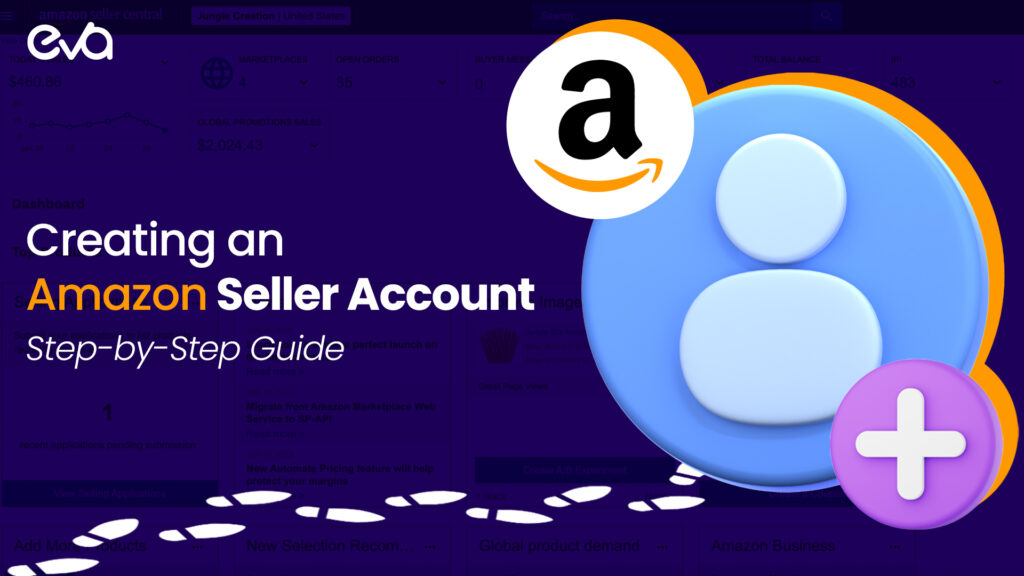Table of Contents
- Introduction
- What is an Amazon Seller Account?
- Types of Amazon Seller Accounts
- Eligibility Criteria to create an Amazon seller account
- Step-by-Step Guide to Amazon Seller Account Setup
- Navigating Amazon Seller Central
- Amazon Seller Account Cost
- Benefits of Creating an Amazon Seller Account
- Tips for a Successful Amazon Selling Experience
- How Eva can help?
- Conclusion
- FAQs
Introduction
Creating an Amazon seller account is a critical step for aspiring entrepreneurs, small business owners, hobbyists, and crafters looking to tap into Amazon’s extensive customer base.
This comprehensive guide will walk you through the entire process, from registration to optimization and beyond, ensuring you have all the information needed to succeed on Amazon.
What is an Amazon Seller Account?
An Amazon seller account is a gateway for individuals and businesses to sell their products on one of the world’s largest online marketplaces.
This platform allows sellers to reach millions of potential customers globally. Registering as a seller on Amazon is a strategic move for anyone looking to enter or expand in the e-commerce space.
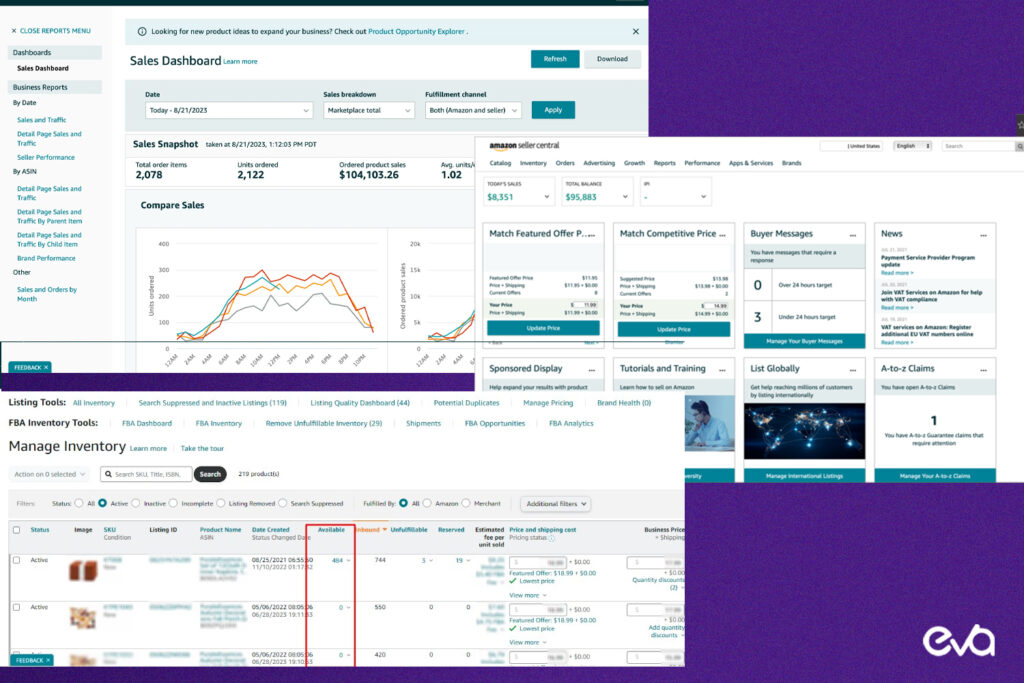
By leveraging Amazon’s robust infrastructure, sellers can manage their inventory, orders, and customer interactions more efficiently.
Amazon provides extensive support and tools through its Seller Central portal, making it easier for sellers to optimize their product listings, track sales, and manage their business.
With the right approach, selling on Amazon can lead to significant business growth and visibility.
Types of Amazon Seller Accounts
Amazon offers three primary types of seller accounts, each catering to different needs and scales of business:
Individual Seller Account
- Cost: No monthly fee, but a $0.99 fee per item sold.
- Best For: Those who sell fewer than 40 items per month.
- Features: Basic listing options, access to Amazon’s marketplace, but no advanced selling tools. Ideal for hobbyists or small-scale sellers who do not need bulk listing capabilities or extensive analytics.

The individual seller account is a cost-effective option for those who are just starting out or sell products infrequently.
Despite its limitations, it allows access to Amazon’s vast customer base and marketplace features.
Professional Seller Account
- Cost: $39.99 monthly subscription fee, with no per-item fee.
- Best For: Those who sell more than 40 items per month and want access to advanced selling tools and reports.
- Features: Bulk listing and order management, access to advanced reporting tools, eligibility for top placement on product detail pages. Additional benefits include the ability to create promotions, gift services, and access to Amazon’s API for automation.
The professional seller account is designed for serious sellers who need advanced tools and services. The monthly fee is offset by the elimination of per-item fees, making it more economical for high-volume sellers.
Vendor Central (By Invitation Only)
- Purpose: For larger brands and manufacturers to sell directly to Amazon.
- Features: Unlike the seller accounts where sellers retain ownership of their inventory, Vendor Central operates on a wholesale model. Brands sell their products to Amazon at wholesale prices, and Amazon takes care of pricing, selling, and customer service.
- Best For: Established brands looking to leverage Amazon’s retail capabilities and marketing power.
Vendor Central provides an opportunity for larger businesses to scale quickly by selling directly to Amazon, who then takes responsibility for the retail process.
This model can lead to increased brand visibility and sales volume, but it also means relinquishing some control over pricing and customer interactions.
Eligibility Criteria to create an Amazon seller account
Age
You must be at least 18 years old to create an Amazon seller account. This age requirement ensures that all sellers are legally able to enter into binding agreements.
Location
Ensure that your country is supported by Amazon for seller registration. Amazon supports sellers from numerous countries, but it’s important to verify if your country is eligible.
Check Amazon’s list of supported countries for registration to avoid any issues during the setup process.
Documents
To register, you’ll need to provide several key documents:
- Valid ID: This can be a passport, driver’s license, or any government-issued ID.
- Bank Account Information: A bank account that can receive payments from Amazon.
- Tax Details: Including your tax identification number (TIN) or equivalent, depending on your country. These details are necessary for compliance with tax regulations.
Importance of Accurate Tax Information
Providing accurate tax information is crucial for compliance with local and international tax regulations. Incorrect or incomplete tax details can result in account suspension, payment delays, and potential legal issues.
Ensuring your tax information is up-to-date and accurate helps maintain smooth operations and avoids complications with tax authorities.
Step-by-Step Guide to Amazon Seller Account Setup

Registration Process
1. Sign Up
Visit the Amazon Seller Registration page and click “Start Selling.” This will redirect you to the sign-up page where you’ll begin the registration process.
2. Provide Information
Enter your name, email, and password to create your account. Ensure that you use an email address you frequently check, as Amazon will send important notifications to this email.
3. Verify Email
Amazon will send a verification code to your provided email. Check your inbox and enter the code on the registration page to verify your email address.
4. Complete Profile
Fill out your seller profile with the required personal and business information. This includes your business name, address, and contact details. Make sure all information is accurate to avoid issues later.
5. Add Payment Method
Link a bank account where Amazon will send your earnings. You’ll need to provide bank account details, including the account number and routing number. This step is crucial for receiving payments for your sales.
6. Provide Tax Information
Enter your tax identification number (TIN) or equivalent for compliance purposes. This information ensures you comply with tax regulations and helps Amazon process your payments correctly.
7. Identity Verification
Upload a valid government-issued ID (such as a passport or driver’s license) and proof of address. Amazon uses this information to verify your identity and ensure the security of the platform.
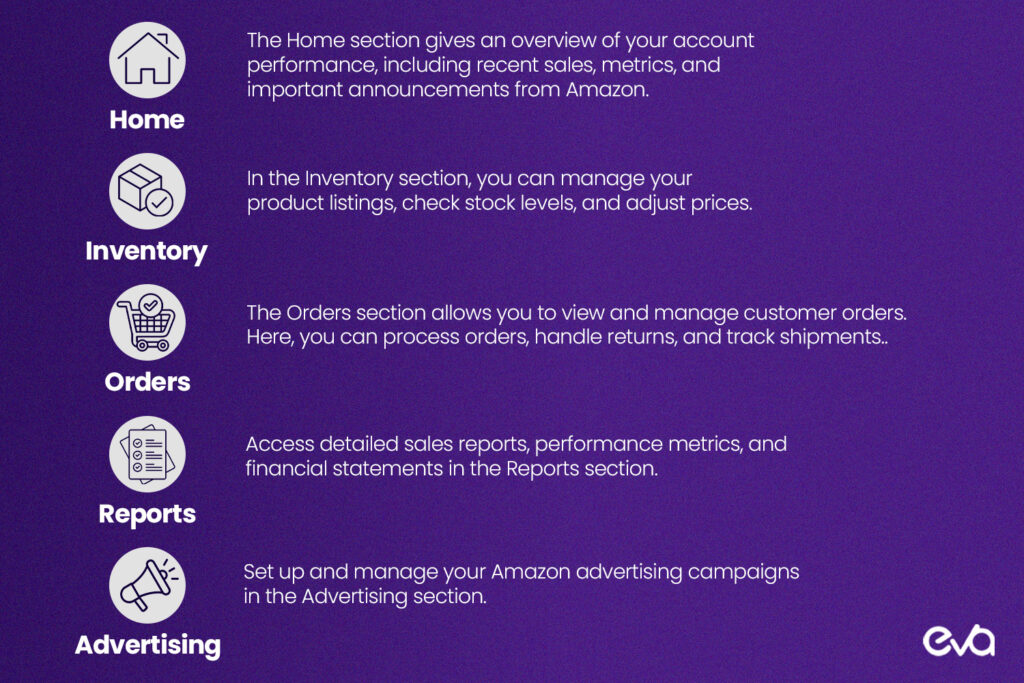
Overview
Amazon Seller Central is your dashboard for managing your seller account. This platform provides tools and resources to help you list products, track inventory, handle orders, and optimize your sales performance.
Home
The Home section gives an overview of your account performance, including recent sales, metrics, and important announcements from Amazon. It’s your go-to page for a snapshot of your business activities.
Inventory
In the Inventory section, you can manage your product listings, check stock levels, and adjust prices. You can add new products, edit existing listings, and ensure your inventory is up to date.
Orders
The Orders section allows you to view and manage customer orders. Here, you can process orders, handle returns, and track shipments.
It’s essential for maintaining smooth order fulfillment and customer satisfaction.
Reports
Access detailed sales reports, performance metrics, and financial statements in the Reports section. These reports help you analyze your sales data, track business growth, and make informed decisions.
Advertising
Set up and manage your Amazon advertising campaigns in the Advertising section. Utilize Amazon’s advertising tools to boost product visibility, drive traffic to your listings, and increase sales.
Amazon Seller Account Cost
Individual vs. Professional Seller Accounts
Individual Seller Account
- Cost: No monthly fee, but a $0.99 fee per item sold.
- Best For: Sellers who sell fewer than 40 items per month. This plan is ideal for hobbyists or small-scale sellers who do not need advanced selling tools or bulk listing capabilities.
Professional Seller Account
- Cost: $39.99 monthly subscription fee, with no per-item fee.
- Best For: Sellers who sell more than 40 items per month. This plan includes advanced selling tools, bulk listing capabilities, detailed sales reports, and eligibility for top placement on product detail pages.
Additional Fees
Referral Fees
Amazon charges a referral fee for each item sold, which is a percentage of the total sale price, including shipping and handling. These fees vary by product category and typically range from 6% to 45%.
Fulfillment Fees
For sellers using Fulfillment by Amazon (FBA), there are fees for storing, packing, and shipping products. These fees vary based on the size and weight of the product.
FBA fees also include services like customer service and returns processing.
Other Charges
- Long-Term Storage Fees: Charged for inventory stored in Amazon fulfillment centers for more than 365 days. These fees are designed to encourage sellers to manage their inventory levels efficiently.
- Advertising Costs: Sellers can use Amazon’s advertising services to promote their products. Costs vary based on the type and extent of advertising campaigns.
- High-Volume Listing Fees: Applicable to sellers with a large number of active listings, typically more than 100,000. These fees help manage the resources needed to maintain extensive inventories.
Benefits of Creating an Amazon Seller Account
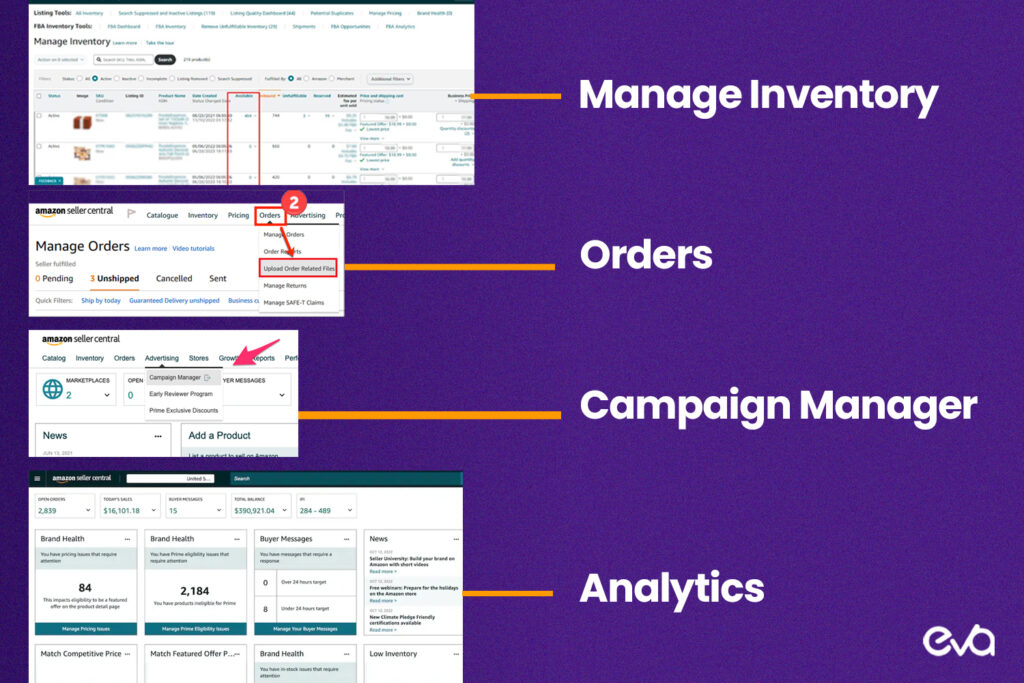
Access to a Vast Customer Base
Selling on Amazon gives you access to millions of potential customers. With over 300 million active customer accounts globally, your products have a higher chance of being discovered and purchased.
Amazon’s robust search algorithms and recommendation systems help connect your products with relevant buyers, increasing sales opportunities.
Credibility and Trust
Amazon’s trusted brand provides credibility to your products. Customers are more likely to purchase from a recognized and reputable marketplace.
Being associated with Amazon’s name can enhance your brand’s reputation, instilling confidence in potential buyers.
Tools and Resources
Amazon Seller Central offers various tools to help manage your business:
- Inventory Management: Track stock levels and restock efficiently.
- Order Tracking: Monitor and process orders seamlessly.
- Advertising Solutions: Promote your products through targeted ads.
- Analytics: Gain insights into sales performance and customer behavior.
Opportunities for Growth
Leverage Amazon’s platform for brand visibility and growth. Amazon offers various promotional tools, including sponsored ads, coupons, and deals, that can help increase your product’s visibility.
Participating in seasonal promotions and special sales events like Prime Day can also boost your sales.
Prime Eligibility
Professional sellers can make their products eligible for Amazon Prime, offering faster shipping options to customers and potentially increasing sales.
Prime eligibility also includes benefits like free shipping, which can be a strong selling point for customers.
Tips for a Successful Amazon Selling Experience
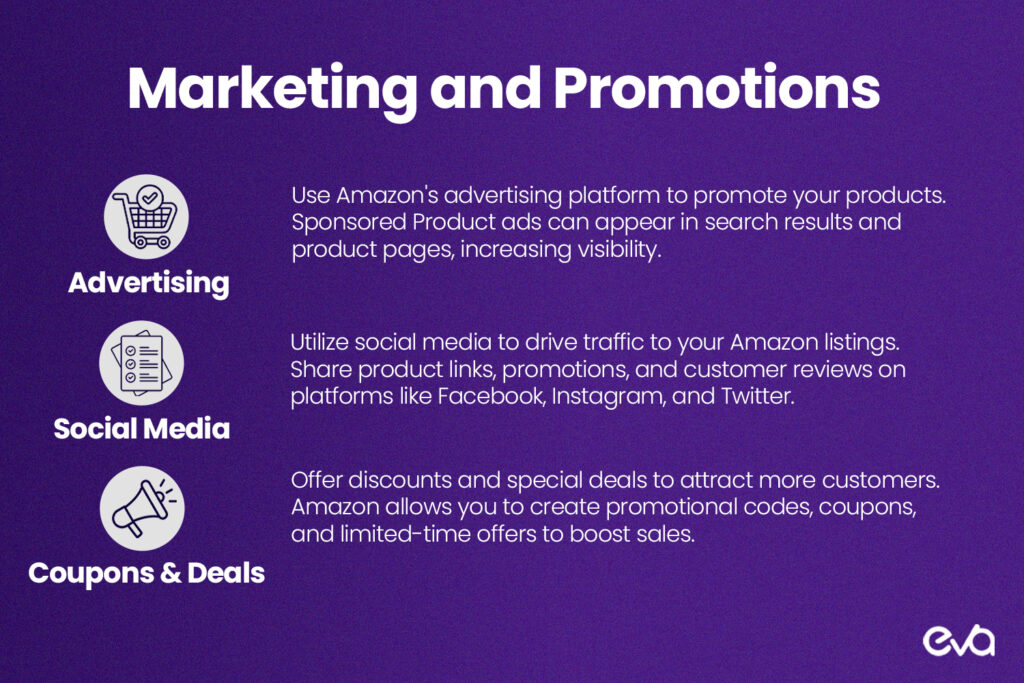
Optimize Product Listings
- Keyword Research: Use relevant keywords to improve search visibility. Tools like Amazon’s own keyword planner or third-party software can help identify high-volume keywords related to your products.
- High-Quality Images: Include clear, high-resolution images that showcase your products. Multiple images from different angles, along with close-up shots of important details, can significantly enhance your listing.
- Detailed Descriptions: Write informative and engaging product descriptions that highlight key features and benefits. Use bullet points for easy readability and ensure you include all relevant product specifications.
Provide Excellent Customer Service
- Timely Responses: Address customer inquiries and issues promptly. Quick responses can prevent negative reviews and foster a positive shopping experience.
- Manage Feedback: Monitor and respond to customer reviews to maintain a positive reputation. Engaging with customers shows that you value their feedback and are committed to providing excellent service.
Marketing and Promotions
- Amazon Advertising: Use Amazon’s advertising platform to promote your products. Sponsored Product ads can appear in search results and product pages, increasing visibility.
- Social Media: Utilize social media to drive traffic to your Amazon listings. Share product links, promotions, and customer reviews on platforms like Facebook, Instagram, and Twitter.
- Coupons and Deals: Offer discounts and special deals to attract more customers. Amazon allows you to create promotional codes, coupons, and limited-time offers to boost sales.
Inventory Management
- Regular Updates: Keep your inventory levels updated to prevent stockouts. Use Amazon’s inventory management tools to track stock levels and set up alerts for low stock.
- Use FBA: Consider using Fulfillment by Amazon (FBA) to handle storage, packing, and shipping. FBA allows you to focus on growing your business while Amazon takes care of logistics and customer service.
How Eva can help?
Eva is an essential tool designed to support new Amazon sellers in optimizing their sales strategies and managing their businesses efficiently.
This platform provides a variety of features tailored to help you succeed in the competitive Amazon marketplace.
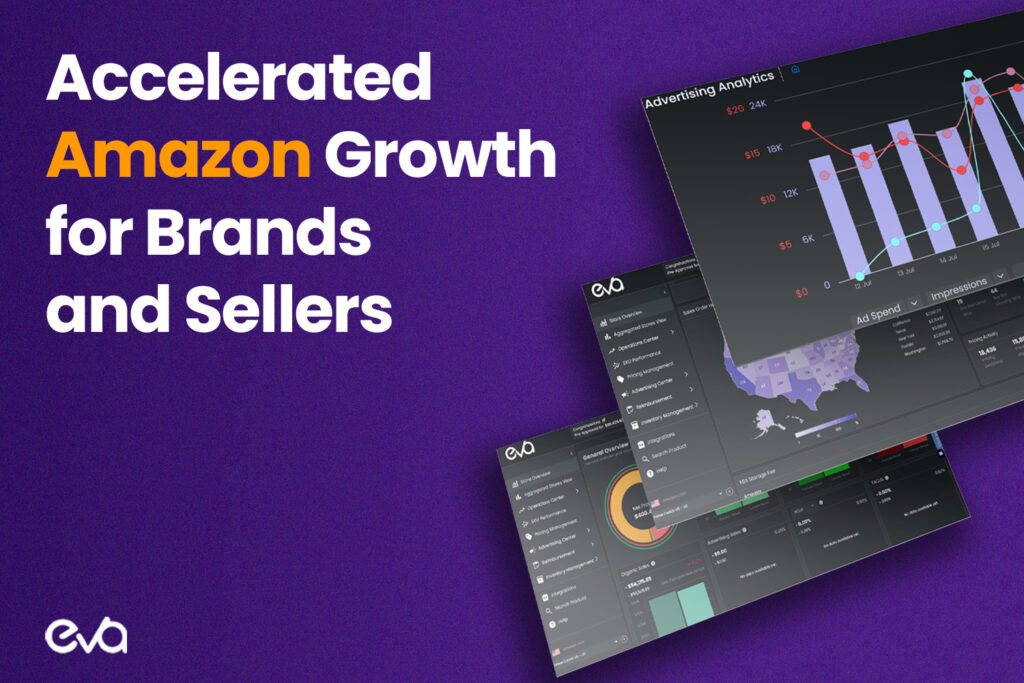
Key Features and Benefits
Dynamic Pricing
Eva’s AI-driven dynamic pricing adjusts your product prices in real-time based on market trends and competitor pricing, ensuring your items remain competitively priced to attract buyers and maximize profits.
Inventory Management
Efficient inventory management is crucial for new sellers. EVA.GURU offers tools to monitor stock levels, forecast demand, and prevent stockouts or overstock situations, helping you maintain a balanced inventory and reduce costs.
Profit Analytics
Eva provides detailed profit analytics, breaking down your revenue, costs, and net profits. This insight helps you identify profitable products and areas for cost reduction, enabling informed business decisions.
Reimbursement Management
Automate the process of identifying and filing claims for lost or damaged inventory with EVA.GURU, ensuring you recover lost revenue and maintain healthy cash flow.
Advertising Optimization
Eva integrates with Amazon Advertising to optimize your ad campaigns, improve ROI, and drive more traffic to your listings, enhancing your product visibility and sales.
Conclusion
Creating an Amazon seller account is a strategic move for individuals and businesses looking to tap into the vast customer base and growth opportunities offered by the world’s largest online marketplace.
By following the step-by-step registration process and navigating the powerful tools available in Amazon Seller Central, sellers can efficiently manage their inventory, orders, and customer interactions.
The choice between an Individual or Professional seller account depends on the seller’s business needs and sales volume.
While the Individual account is cost-effective for small-scale sellers, the Professional account provides advanced tools and features for high-volume sellers looking to optimize their performance.
To succeed as an Amazon seller, it’s crucial to optimize product listings with relevant keywords, high-quality images, and detailed descriptions.
Providing excellent customer service, engaging in marketing and promotions, and maintaining efficient inventory management are also key factors for building a successful Amazon selling business.
Tools like Eva can further support new Amazon sellers by offering dynamic pricing, inventory management, profit analytics, reimbursement management, and advertising optimization features.
By leveraging these resources and best practices, sellers can navigate the Amazon marketplace with confidence and achieve their business goals
FAQs
To create an Amazon seller account, first sign up on the Amazon Seller Registration page by providing your name, email, and password. Next, verify your email, complete your seller profile with business information, add a payment method, provide tax details, and complete identity verification by uploading a government ID and proof of address. Finally, navigate to Amazon Seller Central to manage your inventory, orders, reports, and advertising campaigns
You will need a valid ID (passport or driver’s license), bank account information, and tax details (TIN or equivalent) to comply with tax regulations.
1. Individual Seller Account: No monthly fee, but a $0.99 fee per item sold. Best for those selling fewer than 40 items per month.
2. Professional Seller Account: Costs $39.99 monthly with no per-item fee. Best for sellers of more than 40 items per month, offering advanced tools and reports.
Costs vary by account type: Individual sellers pay $0.99 per item sold, while Professional sellers pay a monthly fee of $39.99. Additional fees include referral fees (a percentage of the sale price) and fulfillment fees if using Fulfillment by Amazon (FBA).
You can sell a wide range of products, including books, electronics, clothing, and handmade items. However, some categories may require approval or have restrictions.
Use Amazon Seller Central to manage your inventory and orders. This platform allows you to track stock levels, process orders, and handle returns efficiently.
Keyword Research: Use relevant keywords for better visibility.
High-Quality Images: Include multiple clear images from different angles.
Detailed Descriptions: Write informative descriptions highlighting key features.
Utilize Amazon’s advertising tools, such as Sponsored Products, and consider using social media to drive traffic. Offering coupons and participating in promotions can also enhance visibility.
Sellers should be aware of referral fees, fulfillment fees (if using FBA), long-term storage fees for unsold inventory, and advertising costs. These fees vary by product category and can impact profit margins.
Provide timely responses to customer inquiries and monitor feedback. Use Amazon’s tools to manage returns efficiently, ensuring a positive shopping experience and maintaining your seller reputation.
Leverage Eva Commerce’s advanced tools and expertise to take your Amazon account to new heights.
Ready to take your Amazon business to the next level? Book a free consultation with Eva Commerce.

